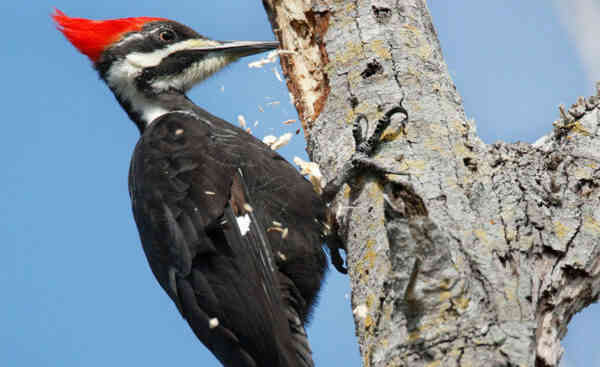Amazing woodpecker birds are notable for the way of life they lead. Tirelessly chiseling trees, they earn their own food, and feel great at the same time. Because of this, there was even a saying about the woodpecker’s head, which does not hurt. Indeed, no other living creature is capable of what this bird does when it wants to eat some bugs or caterpillars.
Interesting facts about woodpeckers
- All types of these birds live alone or in pairs. The only ones that flock together are acorn woodpeckers.
- They are usually reluctant to fly, and never make long-distance flights, spending most of their lives in trees.
- The skull of a woodpecker is larger than relative to body size than most other birds (interesting facts about birds).
- They have an incredibly long tongue that they can even stick out of their beak. Moreover, it is sticky, which allows woodpeckers to easily catch insects by moving their tongue well under the tree bark.
- The weight of the largest woodpeckers can exceed 0.5 kg, and representatives of the smallest species living in South America weigh 7- 8 grams.
- There are as many as 220 species of woodpeckers in the world. For comparison, there are about 9000 species of different birds.
- A loud knock on wood is used by them to communicate with their own kind. So they inform competitors that the territory is already occupied. In the same way, males call females.
- The empty nests of woodpeckers are willingly occupied by tits (interesting facts about tits).
- Great spotted woodpeckers, knocking on a tree, can make up to 20 beats per second. They do it so fast that it is simply impossible to follow the movements of their head.
- Their nostrils are covered with stiff hairs that prevent wood dust from entering the lungs.
- The tail serves the woodpeckers not so much as a rudder during flight, but as a support while crawling on a tree. This bird leans on it so hard that in a year of life the tail is erased by about 10% of its original length.
- The special structure of the head protects the woodpecker’s skull from the effects of blows. Reflexively, each time he knocks on wood, a special muscle pushes the skull and the brain enclosed in it away from the beak (interesting facts about the muscles).
- Most of the impact energy is taken by the cartilaginous tissue located behind the woodpecker’s beak, in front of its head. It serves as a natural shock absorber.
- Not all of their species eat only insects. For example, sucking woodpeckers pierce the bark and feed on tree sap, sucking them out, for which they got their name.
- Large spotted woodpeckers willingly eat not only insects, but also other people’s eggs, and the chicks of other birds can, on occasion, swallow without thinking.
- Almost all birds have three toes pointing forward and one pointing back. And in woodpeckers they are mirrored and symmetrical, two forward and two back. This helps them more confidently cling to the surface of the tree.
- A special delicacy for woodpeckers is ants, which are found in abundance under the bark of some trees, especially old and diseased ones. In this case, a bird can eat up to 800-1000 of them in one meal (interesting facts about ants).
- The acorn woodpecker feeds mainly on these oak seeds. Moreover, he makes stocks for the winter in a very original way – he makes several hundred holes in the tree he has chosen, and puts one acorn in each of them.
- In the mid-90s, because of woodpeckers, NASA space agency delay shuttle launch «Discovery» and do urgent repairs, because a couple of these birds gouged about two hundred holes in the outer layer of its thermal insulation.
- The tips of the tail feathers are very sharp, they even resemble claws or blades.
- Earth woodpeckers too they like to knock, but not on wood, but on the surface of the soil, as they feed on insects that live in the near-surface layer of soil.
- After sucking woodpeckers get drunk on tree sap from the holes they have made, they often flock hummingbirds, who also want their portion. They love juice, but they cannot get to it on their own (interesting facts about hummingbirds).
- Gila woodpeckers living in the USA and Mexico build their nests right on prickly giant carnegia cacti. They feed mainly on insects that gnaw on these same cacti, thereby helping the plant.
